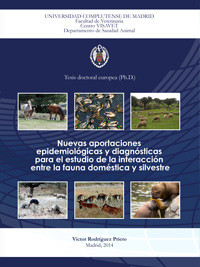Victor Rodríguez Prieto PhD Thesis
 On thursday November 6th Victor Rodríguez Prieto defend his Doctoral Thesis entitled "New epidemiological and diagnostic tools for the study of the interaction between domestic and wild animals" directed by José Manuel Sánchez-Vizcaíno and Joaquín Goyache Goñi.
On thursday November 6th Victor Rodríguez Prieto defend his Doctoral Thesis entitled "New epidemiological and diagnostic tools for the study of the interaction between domestic and wild animals" directed by José Manuel Sánchez-Vizcaíno and Joaquín Goyache Goñi.
Date: November 6th, 12.30 am.
Venue: Sala de Grados, Veterinary Faculty of the Complutense University of Madrid
Abstract:
Wildlife diseases have become increasingly important due to the role of wild animals in infections of major impact on animal and public health, as well as in environmental management. The scenario where wild animals inhabit has changed in recent years, mainly due to anthropogenic factors, which have promoted the creation of situations of interaction between wildlife and domestic animals and/or humans. Considering this human-domestic-wildlife interface (HDW interface) when managing infectious diseases is the best way to cost-effectively allocate resources and achieve an adequate health status.
This thesis entitled New epidemiological and diagnostic tools for the study of the interaction between domestic and wild animals intends to develop, integrate and apply different epidemiological and diagnostic methods focused on various infectious diseases used as a model to study the Spanish HDW interface. Its aim is to cover various types of diseases (i.e. new, exotic and endemic diseases) as well as several hosts (i.e. wild ungulates, wild birds and zoo animals). The work developed in this thesis consists of six papers published in journals of international impact and one in preparation, describing epidemiological models, diagnostic methods, immunological studies and experimental challenges, all of them preceded by an extensive literature review.
The articles included in this thesis describe methods and results that are innovative in the field of infectious diseases and wildlife. They also serve as a model for other diseases, wild species or regions with similar epidemiological features. All the issues raised in this thesis can have direct application to surveillance and control of diseases in wild populations, especially those transmitted in the HDW interface, whose inclusion in comprehensive plans for health management is becoming increasingly paramount.


